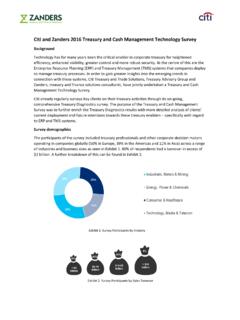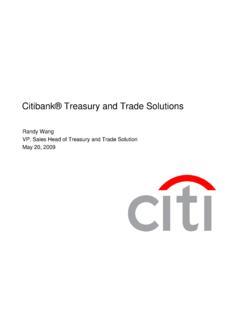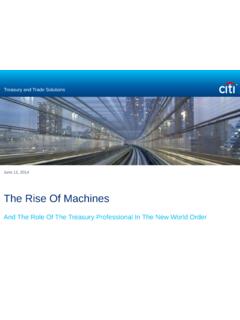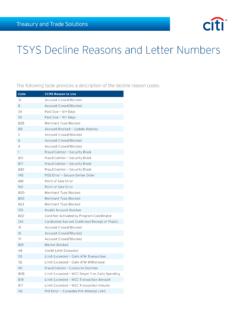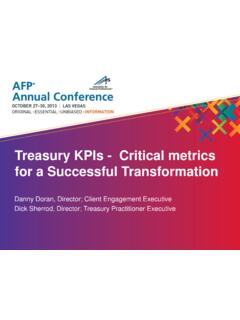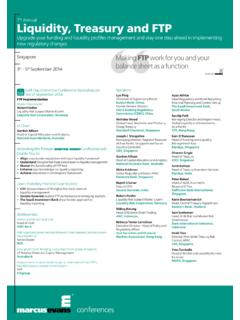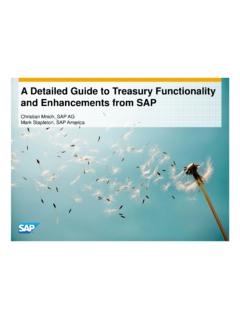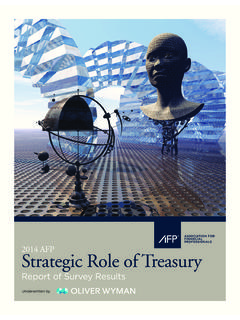Transcription of Finance and Treasury Management - KPMG | US
1 Finance and Treasury ManagementThe transition in today s financial markets, technological development, regulatory requirements and internal changes present complex challenges to corporate Treasury functions. Specialists from KPMG firms around the globe can help keep you on track. Regulation, tax and lawIT systemsAccounting and valuationStay on top of things Today s businesses are exposed to all kinds of constantly changing conditions and factors of influence, be they techni-cal, organizational, structural or regulatory. All these factors impact the Treasury function, compelling organizations to respond without delay. The necessary adjustments are challenging. Yet they are also an opportunity to rethink and optimize existing Treasury processes and realignment requires an integrated approach that takes into account functional requirements, their techno-logical implementation, the design of suitable processes and compliance with a raft of different rules and regulations.
2 A flexible organization and the ability to drive change from the center are crucial success the pivotal role played by the Treasury function in corporate Management and control, all steps to develop and improve this function must make due provision for a wide range of conditions and constraints. A holistic view is also needed to coordinate Treasury processes across divisional particular, due attention must be paid to the IT strategy, accounting rules, tax considerations, legal norms, regulatory provisions, controlling requirements and by no means least personnel issues. This requires an appropriate and broad knowledge in order to fully assess and understand the implications of the wide range of Treasury activities. Lastly, there is usually also the need to manage budget restrictions and personnel many different requirements have to be mastered, it is vital to model strategic topics in appropriate methods and procedures.
3 At the same time, efficient processes and systems must be put in place to enable operational imple-mentation. Successful Treasury departments combine both aspects. To stay on top of so much complexity, KPMG specialists have drawn on their years of experience in financial and Treasury Management to develop an integrated approach that covers these bases. This in turn helps them combine professional consulting with impressive implementation skills. KPMG firms can help develop solutions that incorporate compliance and security considerations clients face. The more than 300 people at KPMG s Global Financial and Treasury Network work closely together, giving you access to a high-performing team whose professional support can help you master challenges and achieve your goals. In line with the standard to deliver every project with quality, on time and on requirements a single, integrated approachStrategy, organization and processesFinancial risk managementCash and liquidity managementCommodity and energy managementPayment transactionsAreas of consultingImplementation skillsPayment transactionsCommoditiy and energy managementCash and liquidity managementYour challenges and how KPMG firms can help Accurately and exhaustively inven-torying the group s financial risk positions as the foundation for effective risk Management Clear and efficient hedging strategies to minimize risks effectively while optimizing transaction costs Transparency about how financial risks affect the balance sheet and profit and loss as a precondition for clear communication with the capital market Precise knowledge of current liqui dity and projected cash flows Identifying the relevant cash drivers and the levers to control them Reducing the cost of internal payment transactions Improving interest income
4 Through cash pooling Identifying and assessing enterprise-wide risk exposure Optimizing suitable hedging strategies and instruments Centralizing risk Management and establishing suitable governance Selecting and introducing commodity trading and energy Management systems Assessing and modeling hedge accounting measures Ensuring security and compliance in payment transactions Cutting costs with centralization, automation and standardization Integrating innovations and new developments such as mobile payment, eBAM and T WIST in the Treasury function Identifying risk drivers and setting up an early-warning system for risk items in the context of currency, interest, credit and default risk Management Identifying your organization s risk appetite and its risk-bearing capacity Designing and testing of risk strategies and Management models Supporting the financial risk Management organization and their operational processes Building an accurate reporting system (a risk Management cockpit )
5 Tailored to the needs of its target groups Designing and handling the technical implementation of integrated liquidity planning and analysis Establishing a system of value-based liquidity Management Assessing the risk/return profile for capital investments and developing tax optimization concepts Designing and implementing an in-house bank to manage intercompany payments Setting up tailor-made cash pooling structures and assisting with the selection of banks Designing appropriate tax terms and charge rates for enterprise-wide cash Management Designing an exposure evaluation and group wide consolidation system Introducing ratios and scenarios for risk analysis Developing and optimizing hedging strategies, end-to-end processes and risk Management organizations Advising on the IT-related implementation such as market databases, inventory Management systems and at-risk methods for commodity and energy risks Advising on appropriate charge rates when implementing central purchasing and hedging strategies Performing payment transaction compliance checks Strategy consulting on payment transactions (business model, opportunity analysis, business case) Designing and implementing solutions for internal and external payment transactions (payment/collection factories, shared service centers) Assisting with the selection of banks (RFPs, beauty contests) Setting up technical connections (formats, connectivity, e -banking)Financial risk managementImportant topics for your company Benchmarking and reviewing to ensure proper order, security and efficiency Consulting on M&A transactions.
6 Establishing new Treasury organizations or integrating existing Treasury units Aligning Treasury organizations with current challenges and cost targets Reengineering processes in light of strategic objectives and compliance requirements Supporting the production of guidelines and organizational design Analyzing and optimizing market data supply Launching and validating valuation models for financial derivatives, stock option programs and complex financing structures Advising on how to implement and optimize the recognition of financial instruments in accordance with existing IAS, IFRS and HGB provisions, especially with regard to hedge accounting requirements Designing, implementing and testing/supervising the transition to the IFRS 9 provisions that will be applicable in future Defining and establishing a reporting system to meet disclosure requirements Analyzing and designing system architectures and interfaces Selecting, introducing and optimizing suitable Treasury Management systems and reporting platforms Assuring quality and performing tests/inspections during projects to launch or improve IT systems Performing health checks for existing system environments with regard to process efficiency, functionality, system operations, costs and sustainability Designing and optimizing the Treasury reporting system Providing tax advice on the design of the Treasury organization and the treatment of financial transactions Analyzing implications and advising on implementation of financial market regulations (EMIR, MiFID, REMIT)
7 Performing the mandatory EMIR compliance audit stipulated by the Securities Trading Act in Germany Advising on supervisory implications for Treasury organization Analyzing the impact of tax-related and supervisory initiatives (FATCA, financial transaction tax, Basel III) Benchmarking the Treasury function against your peer group and plotting a Treasury road map Striking the right balance between efficiency and compliance require-ments Reorganizing and adjusting the Treasury function in line with new requirements (centralization, setup of a Finance company, corporate transactions such as carve-outs or mergers) Implementing valuation methods in line with market requirements Applying accounting methods with secure audit trails, especially in the context of hedge accounting Accompanying the transition to IFRS 9 Cutting costs by standardizing reporting Homogenizing system landscapes that feature numerous interfaces and manual activities Eliminating uncertainties about the future orientation of the Treasury s IT landscape Reducing the cost and effort involved in Treasury reporting while making it more relevant to users Applying new technologies such as cloud computing and big data in Treasury contexts Launching legally independent Finance companies Implementing the requirements of EMIR and REMIT Assessing the impact of regulatory initiatives Minimizing tax risks arising from cash pools and financing measures Important topics for your companyStrategy.
8 Organization and processesAccounting and valuationIT systemsRegulation, tax and lawSelected dimensions of Treasury activitiesA global network of interdisciplinary knowledge The specialists in our team possess a wealth of hands-on knowledge in both content and methodology issues, as well as in matters relating to processes and system repository of specialist knowledge on Treasury -related challenges and trends is made available locally via the global KPMG network. It is complemented by the local teams in-depth knowledge of country-specific from providers and banksThe KPMG team maintains close working relationships with the leading IT providers and banks. At the same time, we maintain our own strict independence, focusing solely on the needs of our clients. Perfectly placed to serve youMethodological and specialist knowledgeMethodological and specialist knowledge covers a variety of aspects of financial and Treasury Management .
9 KPMG firms are thus able to provide their clients with no-gaps solutions , meeting their Treasury needs from a single source. Com-prehensive support can be delivered for everything from orga nizational and process issues to IT solutions , reporting, accounting and regulatory matters. Some firms are also happy to assist with tax and legal* aspects from analysis to design to more information, visit us risk managementRiskratiosCurrencyhedgingPeopl e andexpertise Post merger integration Post carve-outdevelopmentHedgeaccounting Fair value recognitionEmbeddedderivatives Market datasupplyCVA / DVAP latform design and selectionInterfaces IT securityTreasur y reportingExposure calculationHedgingstrategyMarket valuation Derivatives and supply agreementsSimulations and risk limitsGlobal payment formatsTWISTB anking policy and eBAMP aymentfactoryLiquidity analysis and managementLiquidityplanningAccount state-ment processingDimensions of Treasury activitiesStrategy, organization and processes Financial risk Management Regulation.
10 Tax and lawRaw materials and energy managementCash andliquidity managementAccounting and valuationPaymenttransactionsIT systemsCashpoolingCost optimizationMobilepaymentsBank connectivityEMIR / DFA / REMITF inancial transactiontaxOperatingfacilitiesCharge rates and withholding taxMiFID II / MiFIRI nterest strategyScenarioanalysisRisk-bearingcapa cityCash managementIn- housebankSelection ofcommodity riskmanagementsystemCommodity hedgeaccounting CentralizationProcessefficiencyFinanceco mpanyExplanatory notes System operationImpact ofBasel IIIC omplianceTREASURYW ider definitionNarrower definition* Legal services are provided by KPMG Rechtsanwaltsgesellschaft mbHFinancial statusTo learn more about financial and Treasury Management , go here:The information contained herein is of a general nature and is not intended to address the circumstances of any particular individual or entity. Although we endeavor to provide accurate and timely information, there can be no guarantee that such information is accurate as of the date it is received or that it will continue to be accurate in the future.










